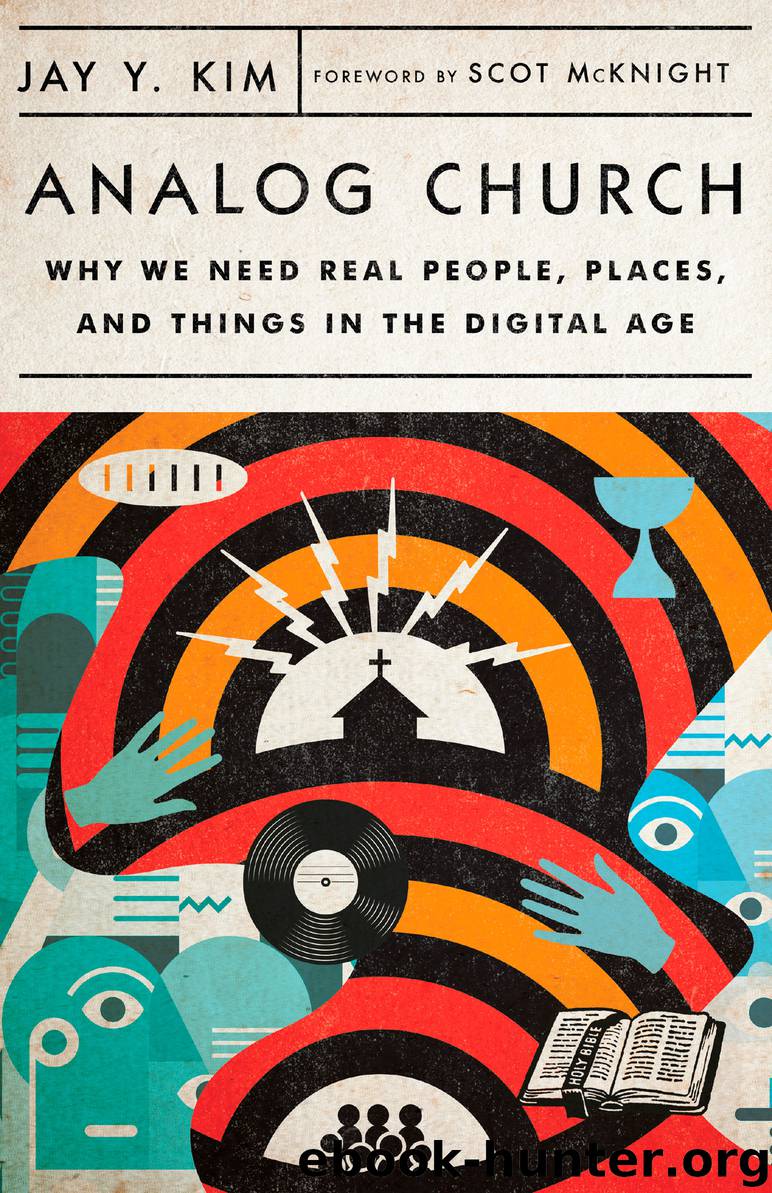Analog Church by Jay Y. Kim

Author:Jay Y. Kim
Language: eng
Format: epub
Publisher: InterVarsity Press
Published: 2020-01-22T09:19:11+00:00
YET, HERE WE ARE
In Matthew’s Gospel, there is a brief description of the twelve apostles, Jesus’ closest friends during his earthly ministry:
These are the names of the twelve apostles: first, Simon (who is called Peter) and his brother Andrew; James son of Zebedee, and his brother John; Philip and Bartholomew; Thomas and Matthew the tax collector; James son of Alphaeus, and Thaddaeus; Simon the Zealot and Judas Iscariot, who betrayed him. (Matthew 10:2-4)
Only two characters have unique descriptors attached to their names: Matthew, who is noted as a tax collector, and Simon, who is noted as a zealot. These descriptors seem trivial to us today, but in the first-century Jewish world they were shocking. As a tax collector, Matthew was a Jewish man employed by the Roman government. Tax collectors were almost always corrupt, allowed by Rome to skim off the top as they collected taxes from their own people on behalf of the oppressive ruling empire. Tax collectors were seen and treated as traitors who were getting rich by stealing from their own people under the authority of the enemy. Zealots stood on the furthest opposite end of the sociopolitical spectrum. They were fanatical, anti-Rome activists who used violent means in their attempts to overthrow their oppressors. They didn’t simply attack Roman soldiers; some of their favorite targets were tax collectors, being the traitors that they were.
Jesus, in handpicking the young men who would follow him and eventually be tasked with launching the Christian movement, intentionally includes both a tax collector and a zealot. Imagine the dissonance and resentment between them. Imagine the primal urges both men must have felt from time to time. Simon very well may have needed to suppress his desire to pounce on Matthew and pummel him with anything he could get his hands on. Matthew very well may have existed in a constant state of anxiety and fear, looking over his shoulder, wondering where Simon was at all times, afraid of bloody retribution coming his way. And yet, we read nothing of that in the Gospels. It doesn’t mean the tension didn’t exist. Almost certainly it did, especially early on in their years together with Jesus. But what it also means is that somehow, some way, these two diametrically opposed individuals experienced, and at some point, embraced one another as brothers brought together by a force much stronger than any of their own past histories, experiences, and opinions of one another.
At some point, Simon and Matthew must have looked at each other and thought, I did not choose you. You did not choose me. Yet, here we are.
This beautiful ethic of the Jesus way of life is amplified in later writings. The apostle Paul, himself once a persecutor of the Christians, writes, “Live in harmony with one another. Do not be proud, but be willing to associate with people of low position. Do not be conceited” (Romans 12:16). Peter, who had been with Jesus alongside Matthew and Simon, writes, “All of you, be like-minded, be sympathetic, love one another, be compassionate and humble” (1 Peter 3:8).
Download
This site does not store any files on its server. We only index and link to content provided by other sites. Please contact the content providers to delete copyright contents if any and email us, we'll remove relevant links or contents immediately.
| Clergy | Devotionals |
| Faith | Inspirational |
| Meditations | Monasticism & Asceticism |
| Prayer | Prayerbooks |
| Ritual | Sermons |
More Language of Letting Go: 366 New Daily Meditations by Melody Beattie(2436)
The Holy Spirit by Billy Graham(2408)
To Light a Sacred Flame by Silver RavenWolf(2350)
The Secret Power of Speaking God's Word by Joyce Meyer(2248)
Tuesdays With Morrie by Mitch Albom(2166)
The Lost Art of Good Conversation by Sakyong Mipham(2124)
The Traveler's Gift by Andy Andrews(2007)
Kundalini by Gopi Krishna(1821)
A Kingsbury Collection by Karen Kingsbury(1716)
Finding Chika by Mitch Albom(1646)
Angels of God: The Bible, the Church and the Heavenly Hosts by Mike Aquilina(1625)
As a Man Thinketh by James Allen(1579)
Angels by Billy Graham(1546)
The Yoga of Jesus: Understanding the Hidden Teachings of the Gospels by Paramahansa Yogananda(1522)
Curse Tablets and Binding Spells from the Ancient World by Gager John G.;(1509)
Barking to the Choir by Gregory Boyle(1503)
Autobiography of a Yogi (Complete Edition) by Yogananda Paramahansa(1485)
How To Be Born Again by Billy Graham(1402)
Anxious for Nothing by Max Lucado(1394)
